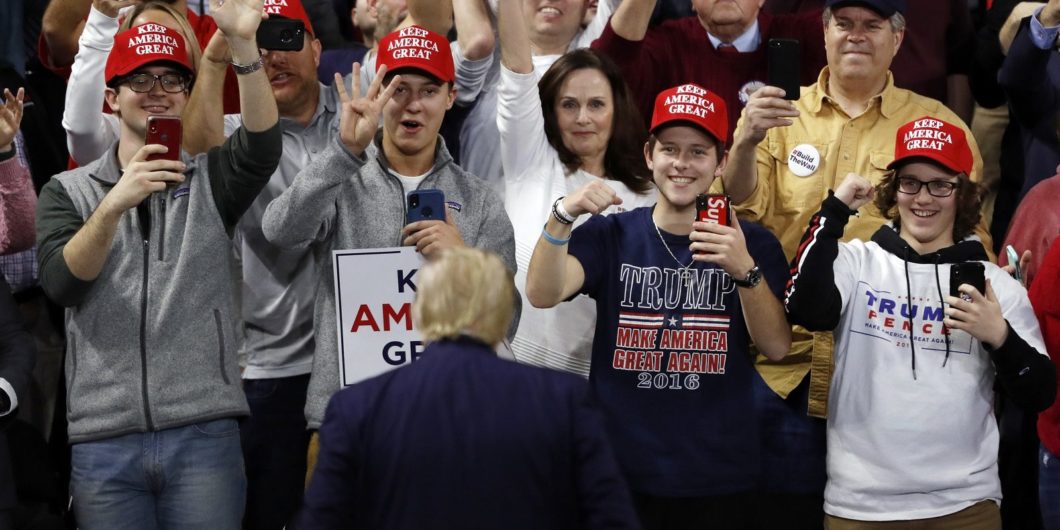Andrew Seidel misunderstands: America’s founders embraced the freedom of religion; not freedom from religion.
A Better Conservatism Requires a Better Firmament
I attribute today’s friction on America’s political right to three factors. The first relates to the enduring difficulty of translating the principles of conservatism into practice. American conservatism is made up of a number of governing tenets that, though related in purpose and often mutually reinforcing, can at times point us in different directions. For instance, conservatives prize individual liberty, community cohesion, tradition, and small-scale democratic governing. But a local ordinance regulating gambling likely puts those principles into tension. Similarly, it’s impossible to simultaneously maximize business innovation, creative destruction, the preservation of longstanding institutions, and the protection of local crafts and trades. So while Russello is correct that the American right combines an intellectual movement as well as a movement dedicated to politics and policies, we should appreciate that the two will never perfectly mesh.
On any given day, different conservatives will rank-order conservative principles differently. But even more confusingly, as social, economic, and political conditions change—and therefore new problems, needs, and opportunities arise—the relative importance of conservative principles will shift. The Warren Court’s audaciousness called for prioritizing judicial deference, the New Deal’s and Great Society’s centralization called for a return to federalism and localism, the technocratic hubris of Kennedy’s “whiz kids” and Obama’s social and behavioral science approach demanded greater governing prudence. So conservative leaders must always be tuned in to the situation at hand, and they must be deft in their thinking and acting. The proper application of conservative principles to real-life situations is almost always a blurred and moving target, so some intra-conservative squabbling is inevitable.
Second, though the socio-political environment is forever changing, we are living through an era of profound shifts in jobs, norms, technology, demographics, and more. This has put society under enormous strain, but it has also demanded extraordinary insight, foresight, and judgment on the part of conservative thought-leaders and policymakers. When a factory town loses its dominant employer, do we cheer the opportunities presented by market dynamism and encourage people to pick up and move, or do we aim to preserve the town’s character, customs, and relationships? Does our social fracturing call for national solidarity or local differentiation and empowerment? Under normal circumstances, it is difficult to ably reorder conservative principles on the fly and develop smart, temporally responsive policy proposals. But under today’s chaotic, fast-changing conditions, the demands are mammoth.
Third, for a host of unfortunate reasons, the “conservative firmament” (the apt term used by Gerald Russello) was simply not up to this task.
The ripples of this failure were first seen in the conservative agenda’s inability to adequately address pressing issues of the day—deindustrialization, immigration, men out of work, opioids, judicial adventuring, administrative-state overreach—leading to reasonable public doubts about the conservative establishment’s capabilities. On the upside, this led to some fresh thinking and new voices. But it also raised questions about the meaning and relevance of conservatism, which unfortunately enabled some twisting, even some disfiguring, of this approach to governing.
Reviving and stabilizing conservatism—unifying is too ambitious a goal—will require recommitting to its principles and understanding how they can be brought to political and policy life. Success in both areas will depend upon the development of a new generation of conservative thinkers and doers. But first we have to understand why the “conservative firmament” failed.
Education, Energy, and Experience
I understand the conservative firmament, perhaps more expansively than Russello’s definition, as the collection of establishment leaders and organizations that generally spoke on behalf of and often developed the ideas and policy proposals for governing leaders. I often call this the “commentary class;” I include think tank leaders and researchers, various public intellectuals, opinion journalists, and radio and television analysts. Although I hold many of these individuals in high regard and although not all of the criticism below applies to the sector as a whole (much less to each member), I see four general problems.
The first is that over the course of at least two generations, we did entirely too little to ensure that the firmament was well versed in the mountain of thinking and writing that serves as the foundation of American conservatism’s principles. Though in recent years an array of conservative courses of study and fellowship programs have emerged, for decades secondary schools and colleges have done little to familiarize future leaders with Burke, Tocqueville, Hayek, Friedman, Nisbet, Kirk, Oakeshott, Sowell, Thatcher, Scalia, Publius, Brutus, and other key figures. Unless a young person lucked into the right school or professor’s classroom, she could enter public service with a bachelor’s degree but little knowledge of this work. So even a great summer enrichment program would be building on an unsound foundation. Worse, little was done to explain to early- and mid-career public-service professionals why concepts like localism, federalism, subsidiarity, tradition, emergent order, markets, nongovernmental action, mediating institutions, and natural rights are essential to American governing. In fact, many of these principles have been explicitly denigrated by the intelligentsia while conservative media generally did little to explicate and defend the principles.
As a result, too much of the conservative firmament seems to have relied on proxies for conservative principles instead of the principles themselves. Policy itself became a reflexive substitute for thinking in a principled fashion, and as a result the firmament behaved as though cutting taxes, limiting government at home, killing terrorists abroad, and protecting free markets were tantamount to conservatism. Such rules of thumb obviously have utility, but they by no means reflect the complexity of American conservative thought nor do they tell governing leaders how to act in most situations. Worse, if applied indiscriminately, such proxies can poorly match citizens’ needs or even do harm.
Second, the firmament proved to be remarkably uncreative. When energy, innovative analyses, and heterodox proposals were needed, the establishment showed rust. Maybe this is because academics are trained to study prior events instead of influence the future, or because public intellectuals—like all intellectuals—are shaped by a dominant paradigm that constrains their thinking. Perhaps it’s because conservatives, as protectors of the past and advocates for incrementalism, are predisposed against novelty. Maybe it’s because the consumers of the establishment’s wares—readers of conservative journals, viewers of conservative cable news, funders of conservative think tanks, firms hiring conservative lobbyists—were quite comfortable with the status quo, thereby disincentivizing new thinking among conservative leaders. Whatever the cause, the firmament’s bent for continuity, so valuable during good times, came across as intellectual lethargy during these tough, uncertain times.
Third, broad swaths of the firmament had (and have) precious little experience in actual governing. On any given day, you could struggle to find many individuals with meaningful governing experience leading policy discussions on major newspapers’ op-ed pages, talk-radio and cable-news programs, and highly trafficked political sites. In fact, days and days could go by before someone with extensive governing experience at the state and local levels would appear. Although this is a problem across the political spectrum, its effects are felt particularly on the right. We have been inundated with analysis, opinion, and forecasting about governing by those personally unseasoned in governing.
This matters because governing authority and responsibility—whether in an elected, appointed, or staff capacity—shapes people in meaningful ways, especially when that public service is close to home. It makes you more aware of other citizens’ daily lives. It forces you to learn the skills of deliberation, accommodation, consensus-building, and compromise. It teaches you about government’s capacities, limitations, and dangers. It forces you to make difficult public decisions. It humbles you. Because much of the firmament has been at a remove from the actual practice of governing in our expansive, diverse republic during an era of profound social, economic, and technological change, they have lost capacity to accomplish a primary function: to incisively and prudently apply the principles of American conservatism to real-life situations.
Today’s disorientation on the right should therefore come as absolutely no surprise. We have unintentionally groomed a movement with too little grounding in conservative principles, too little ability to address contemporary challenges with intellectual verve, and too little understanding about how to actually govern. We had no right to expect that this era’s disruptions would be tamed by a conservatism of brio and effect. Of course we were unable to wisely address immigration, replace Obamacare, mitigate the effects of offshoring and artificial intelligence, or respond to Americans’ growing sense of alienation. Of course we unresponsively responded with tax cuts and rudderless budgets.
And of course we were susceptible to Trump’s substitution of chutzpah and chauvinism for conservatism. And of course the vacuum caused by the dearth of effective, authentic conservative policies was filled by proposals that stretch the definition of “American conservatism” to its limits and sometimes beyond.
Bending and Exaggerating Conservatism
We must recognize that the conservative firmament’s failure weakened the integrity of conservatism’s definition. A strong, successful conservatism could not have been commandeered by Donald Trump’s imprudence, crudeness, centralizing tendencies, tariffs, disregard for governing norms, and so on.
But we shouldn’t see Trump’s behavior and approach to governing as anti-conservative so much as a distortion of conservatism. His is the funhouse mirror of American conservatism: vaguely reflecting the subject but warping it in key ways. His cruelty to progressive opponents is a distortion of traditionalism; his belligerent nationalism is a distortion of community; his war on the “deep state” and governing institutions is a distortion of limited government.
We can see the same bending and exaggeration of conservative governing principles in a slew of ascendant right-of-center arguments and policy proposals. For instance, conservatives understand the importance of solidarity and thick conceptions of the common good; indeed, many people are first introduced into conservatism via communities of faith. But the “post-liberal” movement on the right, particularly assertive forms of integralism, can distort this by disregarding the American-conservative tradition of balancing these principles with a commitment to individual freedom, cultural pluralism, and diverse understandings of the good life.
Similarly, conservatives have long backed narrow policies to support certain types of socially beneficial behavior and disincentivize unhealthy ones—for instance, the mortgage and charitable-giving deductions, various business tax credits, and rules against public drunkenness and prostitution. But conservatives should also understand the dangers of pushing statecraft-as-soulcraft too far: An overbearing government can curtail freedom; central governments have limited ability to collect and analyze economic data across an expansive, diverse landscape; governments struggle to pivot when conditions change; and government tools are inexact and cause unintended consequences. But current right-of-center flirtations with industrial planning across broad swaths of the economy and major regulation of social media seem to be forgetting the dangers of a muscular Uncle Sam.
And conservatives understand the importance of preserving our nation’s territorial integrity and international interests, policing illegal immigration, and prizing unique American institutions and practices. However, this has always been tempered by our devotion to decentralized power and local differences. But again, a current strain of hubristic, centralizing, I-alone-can-fix-it nationalism on the right neglects the essential conservative principle of distributed authority and loyalties.
Conservatives should appreciate that there is some tension among our governing principles, that changing conditions require a continuous reprioritization of these principles, and that we need creative ideas during this turbulent era. All of this argues for some degree of intellectual flexibility. But at the same time, the conservative firmament’s inability to translate conservative principles into effective action in recent years does not warrant playing fast and loose with the meaning of American conservatism.
A Sturdy But Supple Conservatism
Yes, the current state of the political right is cause for some disquiet. But a little historical perspective is in order. The waxing and waning of conservative priorities in response to changing conditions is the natural state of things. Post-World War II centralization produced Road-To-Serfdom conservatism. The strong institutions and social homogenization of the 1950s fostered Eisenhower’s stability conservatism. Concerns about Kennedy-Johnson-era technocratic statism led to Goldwater’s libertarian conservatism. The late-1960s social dissolution produced Nixon’s law-and-order conservatism. 1970s-era stagflation and malaise led to Reagan’s sunny, decentralizing, supply-siding conservatism. Later events caused Contract-With-America conservatism, compassionate conservatism, and Tea-Party conservatism.
Moreover, the posture and priorities of each era’s GOP leader produced a different coalition for the party. Of course there are Republican regulars. But the Ike coalition of 1956 was not the Goldwater coalition of 1964. The Nixon coalition of 1960 was not the Nixon coalition of 1968. The Reagan coalition of 1980 was not the George H.W. Bush coalition of 1988 or the 2004 coalition of George W. Bush. And the current Trump coalition—though prognosticators far and wide seem to think it will define the Republican Party for eons to come—will not be the same coalition of the GOP leader four or eight years from now.
Lastly, a leader’s short-term ascendance to the top of the GOP does not mean, ipso facto, that his or her agenda is fully conservative. Goldwater’s positions could lack restraint and inflate the importance of individual liberty vis-à-vis community. Nixon and Ford were too accommodating of a bulked-up Washington. George H. W. Bush acquiesced to a big tax hike. American conservatism is somewhat supple, but its definition on Wednesday isn’t contingent on what some temporary leader says on Tuesday.
All of this, I believe, argues for two things. First, we need some equanimity in the face of today’s intra-right bickering. History teaches that conditions change, priorities rise and fall, and coalitions shift. Today’s debates are serious, and some of them have gotten overheated. But we should anticipate and welcome meaningful differences of opinion inside of conservatism during an era of rapid change. Conservatism is, at its heart, comprised of prudential judgments about competing goods and current affairs, not formulaic applications of rules.
But, second, these debates are very important. Just because someone asserts that an approach is “conservative” doesn’t make it so. And just because an agenda is “conservative” doesn’t make it politically practical or responsive to the times. Bad things have been done in the name of conservatism, bad policies have been advanced by leaders claiming to be conservative, and conservatism has lost at the ballot box—to bad effect—when it failed to address the public’s concerns.
The American conservative tradition is invaluable. Its meaning should be guarded, and its political viability must be sustained. That requires recommitting to federalism; localism; capitalism; longstanding institutions; social entrepreneurship; and an understanding of individual freedom that supports empowerment, responsibility, innovation, and community—not alienation and license. And bringing those principles to life will require our consciously and doggedly developing and then elevating to positions of influence a new generation of principled, practical, and prudent conservatives of character who know how to govern.



